We use cookies, along with some third-party sites (like Google, Facebook, etc.). By continuing to visit this site you agree to our use of cookies.


- Search Yachts
- Destinations
- Company
- Sailing info
- Blog
Need help? Contact us
If you have ever sailed across the coast of Croatia, you may have been offered with a glass of wine in a local restaurant. And what a good glass it was! Croatia is unbeknown to many, a true paradise for wine lovers. With a tradition spanning since the time of ancient Greeks, who were the first to cultivate grapes, Croatian wines are amongst the best in the world!
If you like to call yourself a bit of a wine connoisseur, read on and discover for yourself all the best Croatia has to offer!
To familiarise yourself better with different types of wines in Croatia while sailing across its coast, first, we will introduce you with a few keywords.
There are three types of wine: red(crno), white (bijelo) or rose (crveno). With regards to flavor they can be either dry (suho) or sweet (slatko).
If you have ever wandered into a local restaurant (konoba) in a Dalmatian coastal town you may have seen that the locals mix deep reds with water in a drink they call "bevanda".
The whites in continental Croatia are mixed with mineral water and drunk as gemišt.
Croatia can be divided into a few key regions of which the three most prominent in wine-producing are:
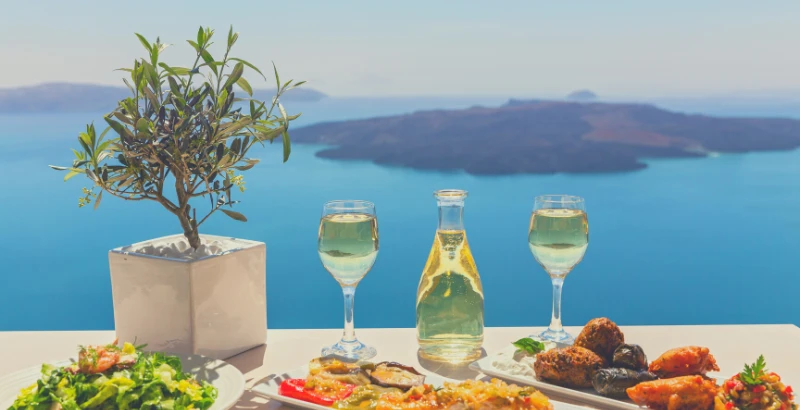
Probably the most beautiful of all the regions of Croatia. Home to its numerous islands and filled with ancient coastal towns dating back millennia.
Dalmatia is also a place to go if you consider yourself a gourmet. From fresh seafood, wonderful cheeses and cured prosciutto to tasty delicacies such as brodet, Dalmatia has something suited for anyone's taste.
But perhaps in no other area of culinary arts are the folks more pleasantly surprised as with the wine. Its improving viticulture is becoming known worldwide.
There are three places to visit while on your Dalmatian sailing tour:
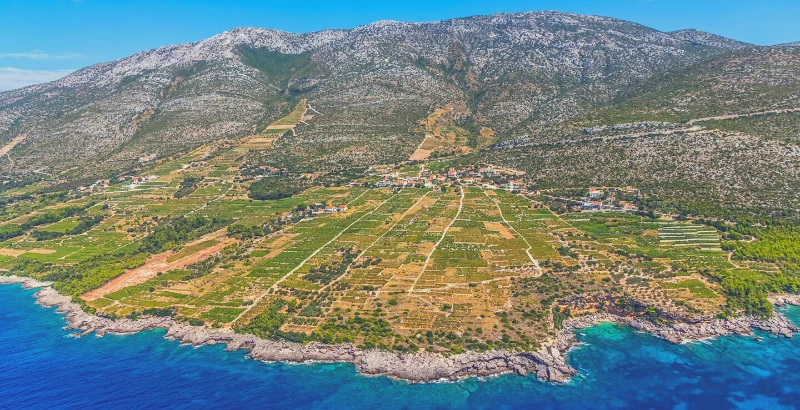
There is no better place to go if you are a lover of red wines. Pelješac, a rocky sliver of land just an hour away from Dubrovnik.
Vineyards are plentiful across the entire Pelješac peninsula, starting all the way from Ston and stretching northwest. They are located in the bowls of fertile soil between Pelješac's interlocking system of mountain ridges.
Although a few varieties of white grapes are cultivated on the peninsula, the velvety red wines produced by the indigenous Plavac mali grape variety are those that make the peninsula so famous.
And when one talks about red wines and Pelješac, the first word that passes one's lips is Dingač.
Dingač
Dingač refers to a seven-kilometer-long stretch of seaside land where Plavac mali grapes grow.
Only grapes harvested on this patch of land have the right to be called Dingač. And there is a reason why farmers cling proprietarily to this distinction. Mostly because of the many favorable conditions that make Dingač wines so worldwide famous.
If you consider yourself a lover of red wine you will be delighted to find out that Pelješac is a region where the quality and quantity of black wines is without precedent.
Another wine growing region on the peninsula just east of Orebić is Postup. It takes its name from the small village that is at the center of the region.
The main grape harvested is Plavac Mali, and like the grapes from the Dingač region, they are held in high regard.
So much so, that Postup was the second Croatian wine region, after Dingač, to be registered for state protection (today Protected Geographical Status) in 1967.
At about 50 ha of the locality Postup, in a good year, it is possible to produce about 2,400 hl of the premium wine Postup. In fact, a good year is one when due to the specific micro-climatic conditions a part of the grapes of the variety Plavac Mali (as well as in the Dingač region over-ripe so that there are about 30% of dry berries, increasing the sugar content and thus making conditions ideal for the production of premium-quality wines.
Most of the wineries are located in the nearby Potomje village, where the tradition of winemakers is a long one. While the wines are not as robust as Plavac Mali-based wines from Dingač, they still have that famous full-body taste.
Postup Mare
Postup Mare is an excellent wine made in the Postup region of the Pelješac peninsula by the small family winery Mrgudić. Mrgudić family has a winemaking history spanning 12 generations, dating all the way back to the Dubrovnik Republic. All the wines produced are made from 100% Plavac Mali grapes and the whole family is included in the production. Mrgudić winery does not use large machinery and is focused on organic winemaking.
The vinification is done in a traditional way with the fermentation of its own yeast, for a period of 7-10 days, while the wine matures in oak barrique barrels.
Madirazza Postup
Another high-quality wine from the Postup region, Madirazza Postup is a premium dry or semi-dry wine. It is almost granite red in color with a strong aroma and a full velvet-like flavor.
Winery Madirazza models its wine production on the small French family wine cellars. Its most popular products made in the Dingač and Postup region age for a year in oak barrels, then 6 to 8 months in bottles, and only then they are served on the market.
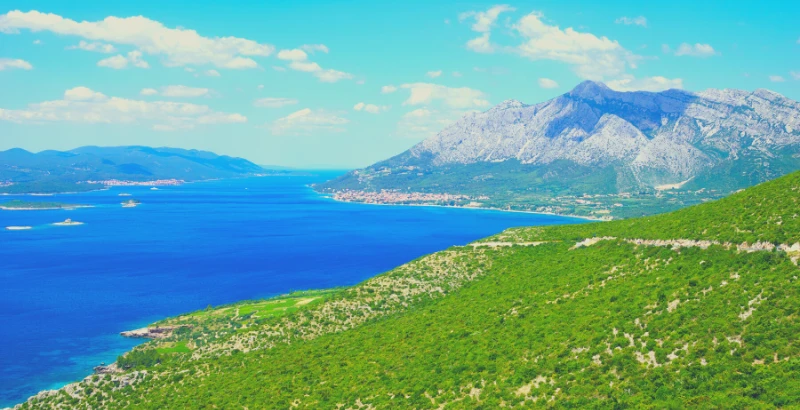
Firstly, the land faces southwest, meaning that the grapes receive the maximum amount of long, sunny Dalmatian days. Secondly, the soil in which the vines grow is rocky which provides the benefit of receiving light's reflection from the rocks for a secondary solar boost. The third and final favorable condition is the incredibly steep hills upon which the fruit grows, meaning that the grapes get a third tertiary installment of sunlight reflected off the sea.
This results in a strong, full-bodied red (in a 14 percent range) with a bouquet that resembles other great wines of the same genre: Sangiovese, Pinot Noir, or Red Zinfandel.
The main difference is that Dingač is somewhat more robust, both in taste and smell. According to the local winemakers, the trick is how to control the strength of the wine without being too controlling.
Wine tourism is becoming increasingly popular in Pelješac, so take the opportunity to cruise along the coast and visit local wineries. Some of the places to visit are Korta Katarina and Saints Hills Winery which have visitors' centers where you can taste wines and buy bottles.
Also, visit the small village of Potomje, full of small family wineries.
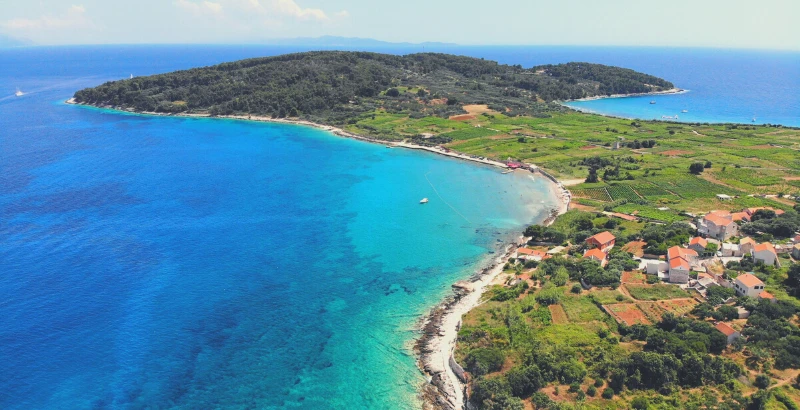
An island known since ancient times, less hyped that Hvar and less busy than Brač, Korčula is the kind of place that might be considered as a little boutique island.
In recent times, Korčula is emerging as a destination that offers intimate upscale accommodation as well as unique natural products.
Korčula was inhabited first by the Greeks, which has left the island with a tradition of wine producing. The eastern part of the island is where most of the vineyards lie, while the western part of the island has the olives.
The terraced hills around towns like Blato and Vela Luka are covered with over 100,000 olive trees, which produce about 10 percent of Dalmatia's total olive oil production.
The hard work and effort that was required for creating the Korčulan landscape hold a special spiritual significance for local wine producers as if their marvelous produce represents a tribute to the toil of the past times. One such wine that seems to embody times long past is Grk.
Grk is one of the oldest grapes on the entire Adriatic. The ancient Greeks who settled on the island more than 2000 years ago left it there. Grk is so localized (attempts to grow it elsewhere have all failed) that the annual production rarely exceeds 25,00 bottles, most of which never leave the island.
When you arrive on the island, be sure to Lumbarda village, where you will have a taste of this hearty wine in a rustic stone room, together with home-made goat cheese and cured prosciutto.
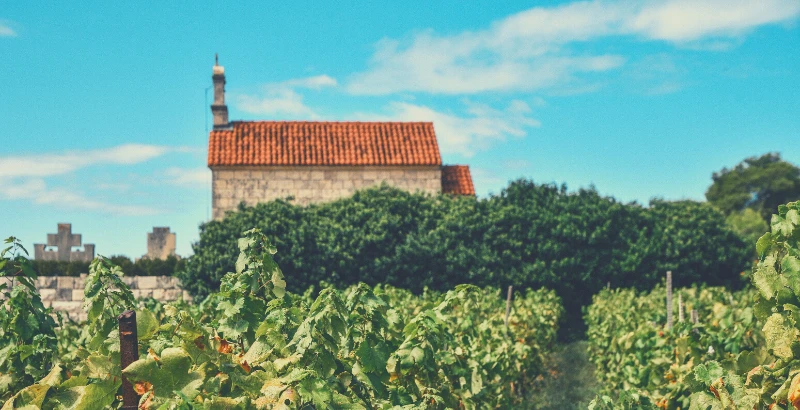
Grk
Grk is one of those vines that only has a female flower, so it needs to be planted next to another grape in order to be pollinated.
Grk produces dry white wines with notes of white pepper, melon, herbs, and sliced pear. The variety is indigenous to Croatia and is only found in sandy soils close to Korčula.
Since Grk wine is so rare, most of the rustic taverns in the island's interior serve Pošip, another extremely high-quality white wine.
Most of the wine production comes from the fields around the villages of Čara and Smokvica.
One of the best places to try Pošip is Konoba Mate in Pupnat, where you can also have a bite of macaroni served with fennel and chili or a home-recipe pasta.
Pošip
Pošip and Plavac Mali are wines of choice for Miljenko „Mike“ Grgich, producer of the winning wine at the Judgement of Paris in 1976. Since then, he has returned to Croatia and dedicated a winery with the aim of producing the finest wines in the whole of Dalmatia.
Pošip wine is often crisp with flavors of apples, vanilla spice, citrus fruit, and a subtle almond note. In the past, it was localized on the Korčula island, but today it has spread across Dalmatia, so you may find it on the Pelješac peninsula as well as on the islands of Brač and Hvar.
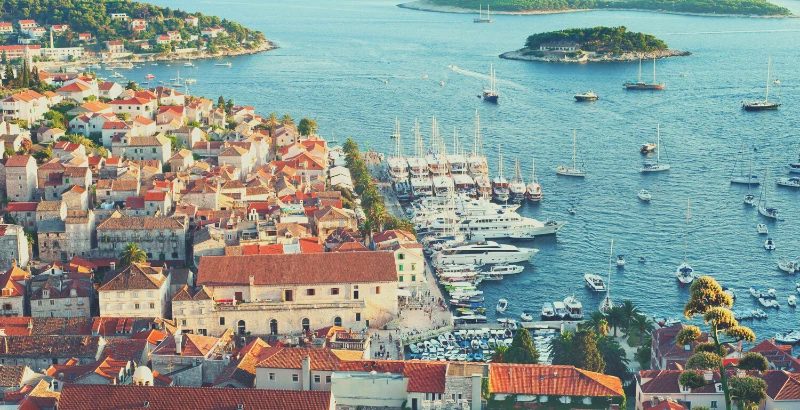
One of the most beautiful islands in the whole of Dalmatia, if not the most beautiful, Hvar is home to high-quality wines as well.
The quality of the wines produced there surely helped the fact that Hvar is the sunniest Croatian island, which gives them their unique flavor and strength.
History of winemaking
Hvar has a rich and old wine-producing history, dating back to 384 BC, from the time of the Ancient Greeks.
Hvar and the nearby islands of Vis, Korčula, and Brač are cradles of Croatian winemaking. Coins with images of grapes and goblets as well as countless archaeological findings related to wine consumption prove that viticulture was of utmost importance to local inhabitants.
Viticulture spread rapidly throughout the region and remained one of the most important aspects of agriculture. At the time of Ancient Rome, its importance rapidly increased.
When the first Croatian settlers inhabited the island, they converted from mead to wine almost instantly.
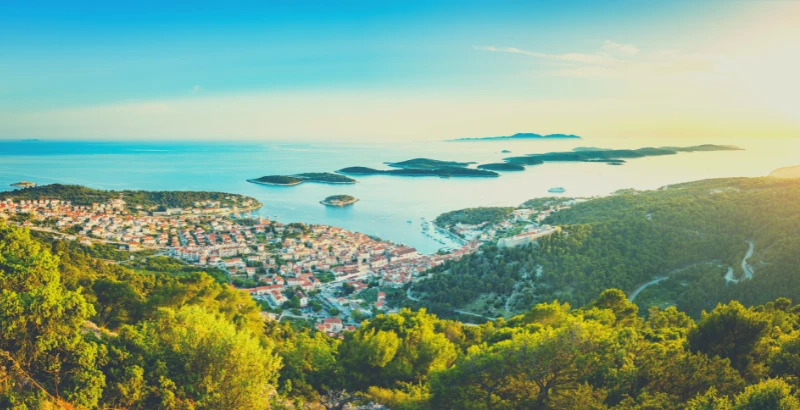
Where are the most famous wine-making regions in Hvar located?
The mountainous shape of the island which spreads from east to west for almost 70 kilometers makes Hvar a perfect home to many indigenous and international grape varieties.
The fact that the island faces in an east-west direction means that the grapes can absorb the full quantity of sunlight during the hot summer days.
Beautiful terraced vineyards around the picturesque villages of Svirče, Vrisnik, Vrbanj, Pitve, and Dol, are where most of the Hvar wineries are located.
Besides these central vineyards on the island of Hvar, there are also famous south-facing vineyards of Medvid Bod, Ivan Dolac, and Sv. Nedelja which spread across the slopes of the mountains.
Thanks to the hard work of local farmers spanning over two thousand years, the karst landscape was turned into arable vineyards, olive groves, orchards, and lavender fields.
The whole of the island is interlaced with dry-stone walls and mounds making the island of Hvar look like a mosaic when seen from the air.
The conditions in the region are ideal for wine production. Mild Mediterranean climate and steep mountain slopes facing east to west ensure that the grapes are grown there and soak up the maximum amount of sunlight possible.
What are the most famous grape varieties grown on Hvar?
The most frequent local varietal of grapes grown on Hvar is Plavac mali. Plavac mali has a moderate level of acidity with rich extract and is significantly high in sugar levels.
Wines made from Plavac mali have a seductive and distinct flavor making them easily distinguishable.
They are often infused with a sweet aftertaste, which is not to be confused with sugar residue.
Another varietal of major importance for this region is Maraština. Although this very famous white varietal has a very long historical background, today it is to be found in small quantities.
This region has many other local varietals to offer which might also be considered indigenous such as bogdanuša, darnekuša, parč, kuč, and pošip.
In recent years, there is an increasing number of international grape varieties grown on the island such as cabernet sauvignon, syrah, and merlot.
Hvar has remained a strong exporter of high-quality wine until the arrival of a deadly phylloxera disease which wiped away a lot of vines.
Unfortunate as it may have been, the resulting emigration from the island has since helped in building the wine stories of countries such as America, New Zealand, and Australia.
What are the most famous wines produced on the island of Hvar?
There is a multitude of high-quality wineries producing the best wines Croatia has to offer. If you want a premium wine-tasting experience while cruising the coast of Croatia, these wines must be on your to-do list.
Zlatan Plavac, Grand Cru
Produced by the Zlatan Otok winery located at the Sv. Nedelja, Zlatan Plavac is made from specially selected grapes of Plavac mali.
Located at the oldest vineyards in the south of Hvar, the average yield per vine is 0.5 kg. It has a very high alcohol quantity by volume of 15%.
The wine ages in barrique barrels of French, American, and Croatian descent and then another 6 months in bottles.
The wine is dark ruby in color and rich in complex aromas which give the impression of prunes, vanilla, and leather.
It is rich in tannins with a retro taste and a persistent aftertaste. This wine has received the highest honors abroad and at home.
Ivan Dolac Barrique
Ivan Dolac Barrique is amongst the best Croatian red wines, produced from the local grape variety of Plavac mali grown on the southern slopes of Hvar island.
The winery producing it PZ Svirče, one of the most famous wineries on the island, famed for its organic wine production.
It is dark ruby red in color, characteristic of the premium quality Plavac mali wines.
It ages in barrique barrels, so it can pride itself on the secondary aromas of blueberries and prunes.
It is a robust wine, with a strong aftertaste, rich in dry extract and abundant in tannins, making the taste elegant.
Duboković Medvid
Made by the Duboković Vina winery, one of the best wine producers in the whole of the island, if not Croatia itself.
Medvid wine is one of their cult classics. Produced from the Plavac mali grapes located in Medvid Bod county, this wine must be on your tasting list.
Aged in barique barrels a year and a half and then poured unfiltered into the bottles.
The result is an eccentric, dense red wine, filled with tannins and with a unique aftertaste that reminds of cinnamon, cherry, and vanilla.
Duboković Medvjedica
Another premium quality wine made by the Duboković winery, Medvjedica is, like Medvid, wine made from the Plavac mali grapes located at Medvid Bod county.
The taste is strong and concentrated, with a very high percentage of both alcohol and dry extract.
The taste is a rustic one, reminiscent of dry plums and chocolate.
The name Medvjedica comes from the fact that an almost extinct Mediterranean Monk Seal (Croatian name Sredozemna Medvjedica) lived in a cave below the sea, just under the vineyard.
Veliki Plavac Mali
Made by the exceptional Tomić Winery located on Jelsa, Hvar, Veliki Plavac Mali is a wine produced only during the most exceptional years and filled in magnums (1,5 l) and can only be tasted on Tomić Winery property.
Visiting said the winery is something that is wholeheartedly recommended, the selection of quality wines is great, and the family gives a tour explaining the whole process of winemaking as well as their origins.
The wine is produced from the exceptional grapes of the local varietal Plavac mali grown on the southern, rocky slopes of the island.
The whole winemaking process, from the cultivation of the grapes to the production is done entirely by hand, just as it has been the case for the past millennia.
The color of the wine is a deep red, while the taste reminds one of ripe fruit, plums, and cherries.
The wine ages in barrique barrels for a year and a half. The wine is exceptionally strong, with 16% of alcohol, it is robust and has a high percentage of acidic content.
With time, the wine develops tertiary aromas, such as tobacco and leather.
Bogdanuša
Translated as 'a gift from God', bogdanuša grapes only grow on Hvar. Originally found on the Stari Grad Plain, a cultural landscape protected by UNESCO that has remained practically intact since it was first colonized by Greeks in the 4th century BC. It is a white wine of a very rich greenish-yellow color, unexpectedly fresh taste, and quite low alcohol content, almost always around 12%.
Those that have tried Bogdanuša say that its taste reminds them a bit of the lavender that is traditionally grown in the Stari Grad Plain, alongside the vines.
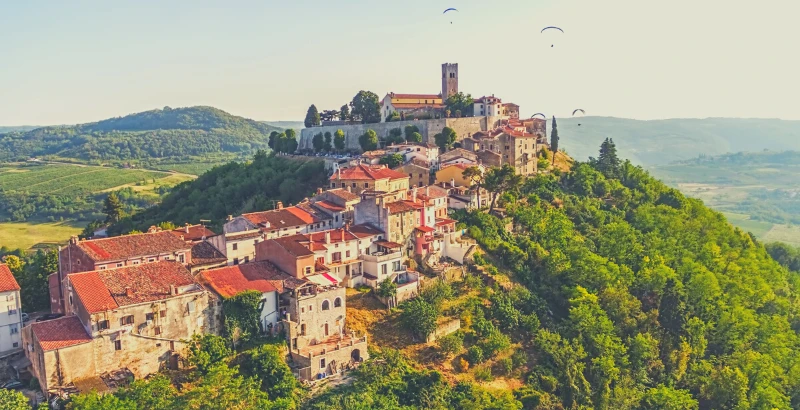
Istria might be considered as „the Tuscany of Croatia“. Filled with numerous high-quality restaurants which serve high-quality local produce grown inland, Istria is a gourmet paradise.
Istrian wine is nowadays another symbol that truly defines the Istrian identity. There are various types of wines that reflect the diversity of climate and soil on which they are grown. Nevertheless, the most famous sort of Croatian wine is the Istrian Malvasia.
Malvasia
Malvazija Istarska is one of the main white wines of Istria and the northern Dalmatian coast. Sometimes it’s called Malvasia Istriana. These wines are refreshing and usually dry, with lower alcohol content and aromas of fennel, quince, honey, apricot, and spice. Malvazija Istarska grows in Istria, one of Croatia’s popular wine travel destinations.
The other popular Istrian wine is Teran. Owing to the reddish land, rich in iron oxide it has a unique taste and is an indigenous Istrian red wine.
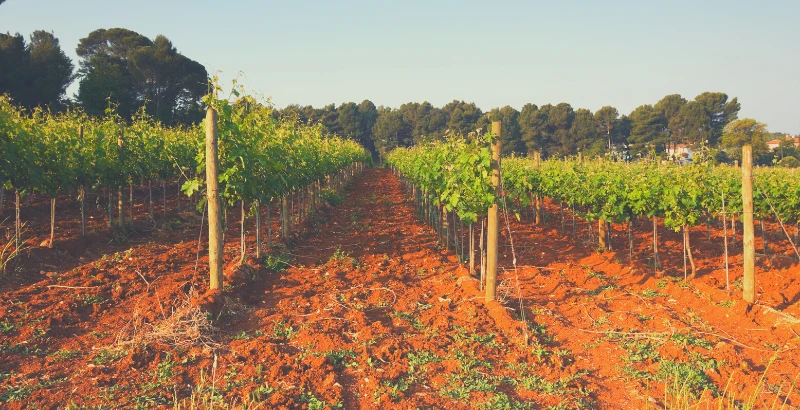
Teran
This is a red grape that grows happily in Istria and seems to absorb the mineral, iron-like quality of the soils in the wines. Teran has bold flavors of forest berries and violets with smoky meat and game-like notes. Teran generally has high tannins and should evolve over a few years.
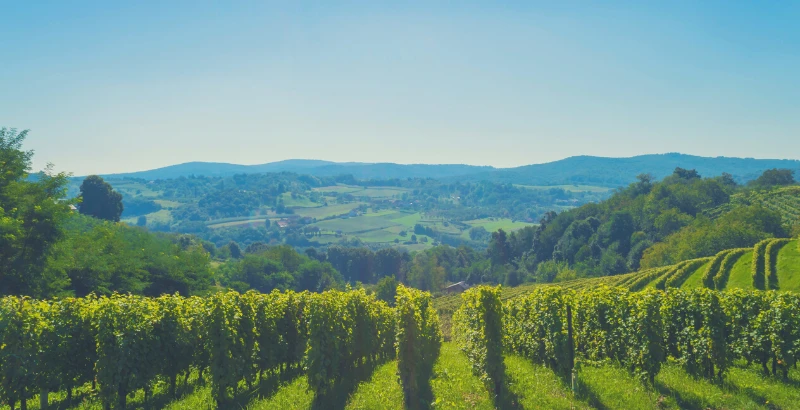
Slavonia, Croatia’s breadbasket, is the home of Graševina, the most common white varietal in Croatia.
According to research, every fifth vine in Croatia produces Graševina. It is highly planted in the Slavonia region, but it can be found almost anywhere in the continental region of Croatia. It thrives on cooler soils and continental climates.
Graševina is highly popular and in high demand so most of this white wine is consumed on the domestic market and is also internationally approved. This is the wine that often receives recognition at numerous international competitions.
Graševina
The everyday wine of Central Europe, Graševina is also known as Welschriesling. It is one of the most popular white wine grapes in Croatia and is so common that it is widely considered to be indigenous. Graševina is a dry, fresh, aromatic white wine with apple-like notes.
Hopefully, with this apprehensive guide, you have been better familiarized with the rich wine-making culture of Croatia, especially abundant in the south of Croatia.
Surely, you now have a stronger incentive to charter a yacht and sail to these magical locations. Croatia is becoming a true jewel of the Mediterranean with many treasures yet to be uncovered, so why not be amongst the first to discover them?
Sailing Routes: 7-Day Dalmatian Sailing Itinerary
Marin @Danielis - November 21, 2017.
5 House Rules You Should Follow Onboard While Sailing
Marin @Danielis - May 19, 2017.
Top Places to Go Snorkeling in Croatia
Marin @Danielis - February 16, 2017.
5 Reasons Why Sailing Is The Best Way To Travel
Marin @Danielis - July 25, 2017.
10 Tips on how to prepare for a Sailing Holiday in Croatia
Marin @Danielis - November 07, 2017.